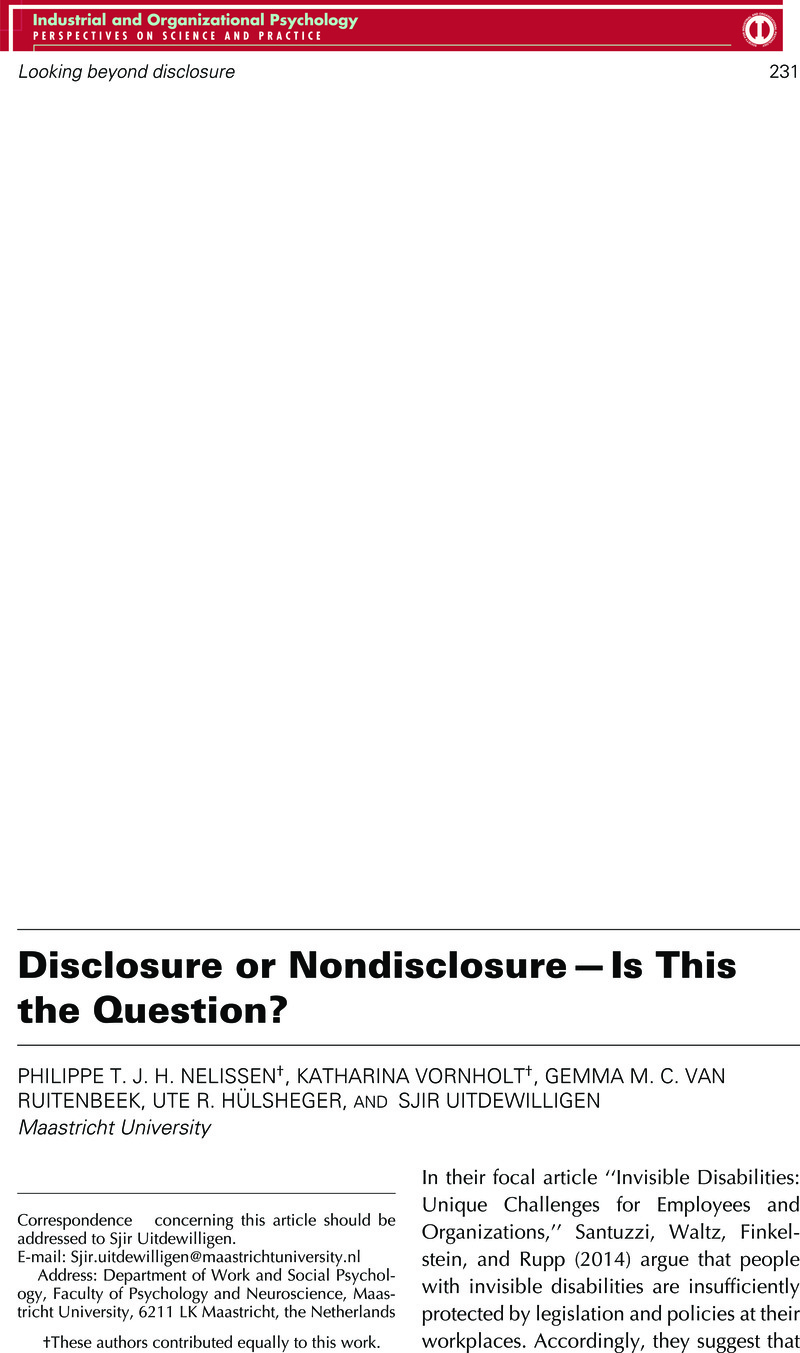Crossref Citations
This article has been cited by the following publications. This list is generated based on data provided by Crossref.
Nelissen, Philippe T.J.H.
Hülsheger, Ute R.
van Ruitenbeek, Gemma M.C.
and
Zijlstra, Fred R.H.
2016.
How and when stereotypes relate to inclusive behavior toward people with disabilities.
The International Journal of Human Resource Management,
Vol. 27,
Issue. 14,
p.
1610.
Nelissen, Philippe T. J. H.
Hülsheger, Ute R.
van Ruitenbeek, Gemma M. C.
and
Zijlstra, Fred R. H.
2017.
Lending a Helping Hand at Work: A Multilevel Investigation of Prosocial Motivation, Inclusive Climate and Inclusive Behavior.
Journal of Occupational Rehabilitation,
Vol. 27,
Issue. 3,
p.
467.
Vornholt, Katharina
Villotti, Patrizia
Muschalla, Beate
Bauer, Jana
Colella, Adrienne
Zijlstra, Fred
Van Ruitenbeek, Gemma
Uitdewilligen, Sjir
and
Corbière, Marc
2018.
Disability and employment – overview and highlights.
European Journal of Work and Organizational Psychology,
Vol. 27,
Issue. 1,
p.
40.
Santuzzi, Alecia M.
Keating, Robert T.
Martinez, Jesus J.
Finkelstein, Lisa M.
Rupp, Deborah E.
and
Strah, Nicole
2019.
Identity Management Strategies for Workers with Concealable Disabilities: Antecedents and Consequences.
Journal of Social Issues,
Vol. 75,
Issue. 3,
p.
847.
Luu, Tuan
2019.
Relationship between benevolent leadership and the well-being among employees with disabilities.
Journal of Business Research,
Vol. 99,
Issue. ,
p.
282.
Ebuenyi, Ikenna D.
Guxens, Mònica
Ombati, Elizabeth
Bunders-Aelen, Joske F. G.
and
Regeer, Barbara J.
2019.
Employability of Persons With Mental Disability: Understanding Lived Experiences in Kenya.
Frontiers in Psychiatry,
Vol. 10,
Issue. ,
Ebuenyi, Ikenna D.
Regeer, Barbara J.
Ndetei, David M.
Bunders-Aelen, Joske F. G.
and
Guxens, Mònica
2019.
Experienced and Anticipated Discrimination and Social Functioning in Persons With Mental Disabilities in Kenya: Implications for Employment.
Frontiers in Psychiatry,
Vol. 10,
Issue. ,
Ebuenyi, Ikenna D.
Rottenburg, Esther S.
Bunders-Aelen, Joske F. G.
and
Regeer, Barbara J.
2020.
Challenges of inclusion: a qualitative study exploring barriers and pathways to inclusion of persons with mental disabilities in technical and vocational education and training programmes in East Africa.
Disability and Rehabilitation,
Vol. 42,
Issue. 4,
p.
536.
Ebuenyi, Ikenna D.
van der Ham, Alida J.
Bunders-Aelen, Joske F. G.
and
Regeer, Barbara J.
2020.
Expectations management; employer perspectives on opportunities for improved employment of persons with mental disabilities in Kenya*.
Disability and Rehabilitation,
Vol. 42,
Issue. 12,
p.
1687.
Granberg, Sarah
and
Gustafsson, Johanna
2021.
Key findings about hearing loss in the working-life: a scoping review from a well-being perspective.
International Journal of Audiology,
Vol. 60,
Issue. sup2,
p.
60.
Østerud, Kaja Larsen
and
Vedeler, Janikke Solstad
2024.
Disability and Regulatory Approaches to Employer Engagement: Cross-National Challenges in Bridging the Gap between Motivation and Hiring Practice.
Social Policy and Society,
Vol. 23,
Issue. 1,
p.
124.





